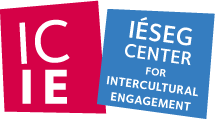Everybody at IESEG, students as well as academic and administrative staff, needs to develop their cultural intelligence (CQ). The Diversity Icebreaker has become one of the mainstays in our “Working Together Toolbox”. We have used it for a number of years with all students who arrive at the school at both the under-graduate and graduate level, and also in our compulsory staff diversity training. We generally use close to 2,000 Diversity Icebreaker questionnaires per year.

Over recent years, we have found that using the Diversity Icebreaker allows us to introduce the concept of diversit y in a very experiential, non-threatening and fun way. As anyone who has facilitated or participated in a Diversity Icebreaker workshop will tell you, the questionnaire and the following team activities do not only involve participants in a uniquely engaging manner, but also generate a shared non-violent vocabulary and understanding around the concepts of blue, red and green. It is not uncommon to hear students and staff refer to the colours in
different contexts at school: from an exasperated “why is my boss so blue” to an exhortative “can we be a bit more green here?” we all know what it means.
We have been lucky to work closely with Bjorn Ekelund and the rest of the Human Factors team to make sure that our workshops were designed and facilitated effectively, and that every member of the Cultural Diversity teaching team was comfortable running these. By staging an impressive number of workshops every year, each of us became very experienced, but we also discovered that – no matter how many you do – each one is different, and they always work. This is what makes a great tool – that you can walk into a workshop knowing that it is going to be fun and that you are almost 100% sure that the learning objectives will be achieved.
Until March 2020, all our Diversity Icebreaker workshops were run in face-to-face sessions, using the classic paper version of the questionnaire, splitting the groups into blue, red and green teams and getting them to produce posters highlighting the strengths and weaknesses of the colour profiles. The lockdown in France due to the corona virus forced IESEG to move all teaching and workshop activities online almo
st overnight. Before, we had never really considered using the online version of the Diversity Icebreaker, even though we knew it existed. DI workshops were an integral part of our integration sessions and so obviously had to be run face-to-face.
In order to be ready for the new students joining IESEG in the late summer, all the members of our team attended the online workshops and experiences offered by Human Factors. Not only were we convinced that the online version of the Diversity Icebreaker could easily replace the paper questionnaire, but we also spotted its benefits: quick and easy access on computer or smartphone, a group chart displaying everybody’s p
So, we decided that we would transition from the paper version to the online version and use this regardless whether our workshops would run online, face-to-face, or in a hybrid format. And that’s what we have done. Since the end of August 2020, we have run close to 100 sessions, both online, face-to-face and hybrid for almost 2,000 participants.
Obviously, running workshops on a scale like this requires immaculate online logistics. Tanja Münchausen at Human Factors AS in Norway was the key account manager for setting up and coordinating the on-line URLs for the different seminars. Each seminar was given a unique URL with a
lace in the team compared to the mean score, and of course, saving on paper and transport.
restricted number of potential users; typically, 5-10% higher than expected in order to have some kind of flexibility. The unique links are important in order to study differences in Diversity Icebreaker results between different classes. It was critical to make sure that the links were accessible at the right time, on the right day and by the right local facilitator. Tanja made it all possible, providing daily support in order to give personalized explanations and feedback to all facilitators, manage changes and follow up on each and every session. A tremendous achievement. Over the 10 weeks or so that we ran the workshops, we never had any technical issues and the links were always set up and ready for us in the most timely of manners.
A huge thanks to Tanja for everything.
Now, what has been our experience? Well, let’s hear what the facilitators have to say:
 Chérif Ezzeldin: I just loved using the online version of the DI. Watching the group profile emerge live on the screen as students completed their questionnaires and being able to share it with them is a real highlight.
Chérif Ezzeldin: I just loved using the online version of the DI. Watching the group profile emerge live on the screen as students completed their questionnaires and being able to share it with them is a real highlight.
It’s also a powerful pedagogical tool. It instantly raises students’ perceptions and understanding of how individual preferences combine and transform the collective characteristics of a group. It helps them put into perspective how their own contributions can influence the group’s overall performance.
Where the paper support experience was a sporty activity with counting, lugging to and from various locations, distributing then collecting back copies, the digital experience is a smooth pleasurable, fun activity that facilitates exchanges, discussions and learnings.
The DI team’s reactivity and efficiency is exemplary.
Heide Hartmann: The online version worked much better than I thought it would.
Paul Devos: I agree with Chérif’s comments regarding Tanja’s follow-up. It worked really well. The only drawback is that we have to go back to the paper copy if we want the students to figure out what respective colours mean.
Jackie Spencer: I agree with Paul, if we use the online version, the students need either the descriptions of the colour characteristics or copies of the paper versions while doing the group work and for the swot. Tanja did a great job and I had no problems with my links.
Michael Ashworth: Logistically and technically, it worked brilliantly. Pedagogically, I just didn’t find a good enough replacement for the old way if getting them in groups and reviewing the questions, working it out for themselves and then, of course, making posters. So, it was less effective. Maybe if students do the test in class and we ask them beforehand to try to commit some of the questions to memory, it could work.
So, bravo to DI for their organisation but I’m still not there yet in exploiting it in the classroom.
Grant Douglas: Like Michael, I struggled at first with ways of dividing the students into teams and getting them to review the meaning of the colours. I ended up using a PdF version of the paper questionnaire. For the posters, it was much easier and I used the Miro white-board platform (www.miro.com). This resulted in some great posters both on-line and in the face-to-face sessions and had the added advantage of allowing participants to become familiar with a very useful collaborative tool. Overall, even if I missed the buzz of the classical workshops, I was more than happy with the online version and I love the group profiles that are generated.
Working with Tanja on setting up the workshops was a real pleasure. Thanks for everything. You rock 😉
Bernd Gibson: Running Diversity Icebreaker workshops at IESEG at the beginning of the term has always been one of the highlights of the year for me. A powerful moment of experience-based learning building awareness of diversity without even tackling the subject of nationality, origin or race.
I was concerned that deploying the online questionnaire and running some of the sessions online or in a hybrid format would weaken the impact. It didn’t. The online tool is perhaps even more appropriate for digital natives who prefer taking a screenshot of their blue/green/red scores to keeping the paper questionnaire. The graph with the combined group profiles also proved an eye-opener and a starting point for discussions about diversity, complementarity and group dynamics.
Changing the format also inspired us to become innovative about the way the workshop was run. Regulations for social distancing made it impossible to get the teams to make paper posters. As for myself, I used padlet.com and asked the blue, red and green teams to highlight the strengths of their colour teams, and to point out the weaknesses of the others. This lead to a dynamic live stream of posts which worked brilliantly both online and face-to-face and created an atmosphere reminiscent of social media. The posts were not always politically correct, but it was FUN.
************
So once again, a million thanks to Bjorn, Tanja and the rest of the team for your support. And to our almost 2,000 students who experienced the Diversity Icebreaker in these very unusual times.
This article was written collaboratively by Grant Douglas, Bernd Gibson, Chérif Ezzeldin, Jackie Spencer, Heide Hartmann, Paul Devos and Bjorn Ekelund.

